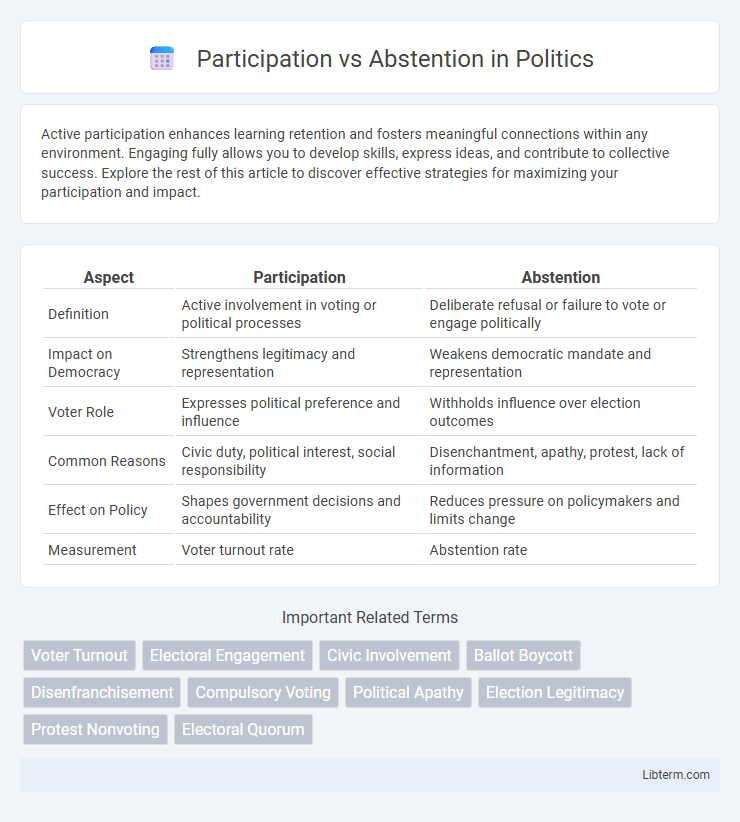Active participation enhances learning retention and fosters meaningful connections within any environment. Engaging fully allows you to develop skills, express ideas, and contribute to collective success. Explore the rest of this article to discover effective strategies for maximizing your participation and impact.
Table of Comparison
| Aspect | Participation | Abstention |
|---|---|---|
| Definition | Active involvement in voting or political processes | Deliberate refusal or failure to vote or engage politically |
| Impact on Democracy | Strengthens legitimacy and representation | Weakens democratic mandate and representation |
| Voter Role | Expresses political preference and influence | Withholds influence over election outcomes |
| Common Reasons | Civic duty, political interest, social responsibility | Disenchantment, apathy, protest, lack of information |
| Effect on Policy | Shapes government decisions and accountability | Reduces pressure on policymakers and limits change |
| Measurement | Voter turnout rate | Abstention rate |
Introduction: Defining Participation and Abstention
Participation refers to the active involvement of individuals or groups in decision-making processes, voting, or civic activities that influence societal outcomes. Abstention denotes the deliberate choice to refrain from engaging in these processes, often signaling dissent, apathy, or strategic neutrality. Understanding the distinctions between participation and abstention is crucial for analyzing democratic legitimacy and citizen engagement.
Historical Perspectives on Civic Engagement
Historical perspectives on civic engagement reveal fluctuating patterns of participation and abstention shaped by socio-political contexts, such as the expansion of suffrage rights and civil rights movements. Significant moments like the 1965 Voting Rights Act in the United States reduced barriers for marginalized groups, increasing voter participation and reshaping democratic inclusivity. Studies show that periods of political turmoil and disenfranchisement often correlate with higher abstention rates, highlighting the importance of accessible voting systems and civic education in fostering engagement.
Motivations Behind Participation
Motivations behind participation in elections often stem from a sense of civic duty, political efficacy, and trust in the democratic process. Individuals who believe their vote can influence policy outcomes or who feel a strong connection to community values are more likely to engage in voting. Social influence, education level, and access to information also significantly impact voter turnout and the decision to participate.
Reasons for Choosing Abstention
Choosing abstention often stems from dissatisfaction with available candidates or political parties, reflecting voter disillusionment and mistrust in the electoral system. Some individuals abstain due to perceived lack of meaningful choice, feeling their vote will not influence outcomes or policy decisions. Other reasons include limited access to voting facilities, lack of information, or internal conflict about the ethical implications of endorsing any candidate.
Impacts on Democratic Processes
Voter participation strengthens democratic processes by enhancing legitimacy, accountability, and representation within governance structures. High abstention rates can lead to skewed policy outcomes, reduced public trust, and weakened institutional credibility. Increased engagement fosters inclusive decision-making, while widespread abstention risks marginalizing key social groups and diminishing electoral mandates.
Societal and Cultural Influences
Participation rates in democratic processes are heavily shaped by societal structures and cultural norms, with communities valuing civic duty exhibiting higher voter turnout. Social trust and collective identity encourage active engagement, while cultural stigmas or historical disenfranchisement contribute to abstention. Media representation and educational outreach further influence perceptions of political efficacy, impacting whether individuals choose to participate or abstain.
Participation vs Abstention in Elections
Higher voter participation in elections strengthens democratic legitimacy by ensuring diverse representation and reflecting the electorate's will more accurately. Abstention, often influenced by political disengagement, distrust, or systemic barriers, can undermine electoral outcomes and skew policy priorities toward active voters. Strategies to increase turnout include voter education, simplifying registration processes, and implementing alternative voting methods such as mail-in ballots or early voting.
Case Studies: Global Trends and Examples
Case studies reveal global trends where voter participation varies significantly based on socio-economic factors, electoral systems, and political stability. In countries like Sweden and Australia, compulsory voting and multi-party systems contribute to high voter turnout, contrasting with lower rates in the United States and India where voluntary voting and political disenfranchisement are more common. These examples highlight how electoral policies and societal trust directly impact citizen engagement and abstention rates worldwide.
Consequences for Policy and Governance
High voter participation strengthens democratic legitimacy and prompts policymakers to address diverse public interests, leading to more inclusive and responsive governance. In contrast, widespread abstention can skew policy priorities toward influential minority groups, undermining representative democracy. Persistent low turnout may erode government accountability and diminish public trust, complicating effective policy implementation.
Encouraging Informed Civic Choices
Encouraging informed civic choices involves providing comprehensive voter education and transparent information about candidates, policies, and election processes to reduce abstention rates. Access to unbiased resources empowers citizens to participate meaningfully in democratic elections, strengthening representative governance. Civic engagement initiatives that emphasize critical thinking and fact-based decision-making foster higher voter turnout and more representative electoral outcomes.
Participation Infographic

 libterm.com
libterm.com